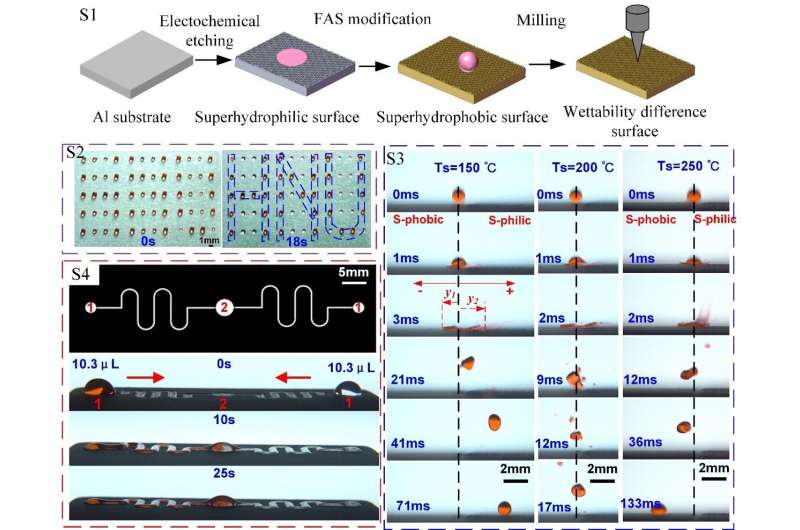Controlled bouncing, evaporation and transport of droplets on a liquid-repellent surface

The research team from Hunan University has proposed a facile and industrially applicable method to fabricate an extreme wettability surface on an Al-based superhydrophobic surface by a composite process of electrochemical mask etching and micro-milling, and achieved the controlled evaporation, directional bouncing and transport of droplets on this surface over a wide temperature range for the first time.
The transport platform based on wettability differences will open more applications in biochemistry, microfluidic systems, cell culture, and energy harvesting and utilization. This research was published in the Journal International Journal of Extreme Manufacturing.
The evaporation rate of droplets on superhydrophobic surfaces was lower than that of droplets on hydrophilic surfaces. Controlled evaporation of droplets on hydrophilic micropit dot matrix, circular groove pattern or other wettability difference patterns can be achieved by controlling the geometry of the hydrophilic pattern.
The directional bouncing of droplet with different distances can be achieved by controlling the magnitude of wettability difference of substrate over a wide temperature. The droplets will bounce towards the more wettable hydrophilic region, the greater degree of difference in wettability, the greater velocity and distance of bounce.
When the substrate temperature is below the Leidenfrost boiling point, the droplet bounces towards the hydrophilic region. On the contrary, droplets bounce vertically at the junction or move towards the superhydrophobic region due to the thrust generated by the vapor layer.
Controlled transport of droplets over a wide temperature range with confluence and split-flow by using Laplace pressure gradients on extremely wettable surfaces was realized. Temperature gradient drive can be used to realize directional and gravity-resistant transport of deionized water, anhydrous ethanol and kerosene with different viscosities, and the droplet migration velocity increases with the temperature gradient.
By analyzing the phenomenon of droplet motion on wettable surfaces, the researchers were able to understand the effect of wettability difference surfaces on droplet motion. The researchers found that the size of hydrophilic area at room temperature affected the evaporation rate and transport direction of droplets, which tended to bounce more toward hydrophilic regions. However, the droplet bounces toward the superhydrophobic region at high temperatures.
The team studied a promising method to industrially prepare wettability-differentiated surfaces, but the experimental technique they have developed can be used for many different applications.
Yao Lu from Queen Mary University of London says that "this is a very valuable and promising achievement and it is only the beginning—we are already looking to use this technique to support the development of bionic functional surface structures, which are needed in industries such as biochemistry, microfluidic systems and energy harvesting and utilization."
More information: Chengsong Shu et al, Fabrication of extreme wettability surface for controllable droplet manipulation over a wide temperature range, International Journal of Extreme Manufacturing (2022). DOI: 10.1088/2631-7990/ac94bb
Provided by International Journal of Extreme Manufacturing





















